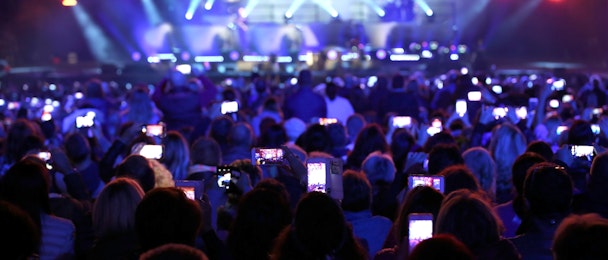The next generation of experiential will be unlocked through your phone’s camera
As part of The Drum’s Experiential Marketing Deep Dive, iProspect’s global digital and innovation director, Max Askwith, looks at how our phones can augment our IRL experiences.

At experiential events or through scannable static media, using the phone to connect offline with online is cementing better data capture and, therefore, personalized experiences. Experiences that, in many cases, now blend the real-world experience with fantastical augmented reality (AR) builds and a whole new layer of engagement to better connect with and build brand loyalty with customers.
Snapchat and Deloitte project that 4.3 billion people will be regular users of AR by 2025 and advances in tech are making it easier and more affordable for brands to seek out these additional layers to traditional experiential events.
It goes without saying that brands and business have faced accelerated disruption over the past few years, from the move to ecommerce and a need for digital transformation to recently changed consumer habits because of Covid-19 and the increasing battle for attention (as discussed in our recent Brands Accelerated whitepaper).
Human nature will continue to draw us together to communal places and spaces and, if shopping isn’t always the magnet, how can brands with a bricks-and-mortar footprint (whether permanent or temporary) innovate consumer experiences in this (not so) new world?
The recent resurgence of QR codes has developed a wider public association of how mobile phones can be used to shortcut the process of discovering relevant information, bridging the gap between inspiration and transaction. Entertaining and social-currency-generating AR experiences have become more prevalent too, led by the likes of Snap and Blippar.
I believe this intersection of culture, content, data and technology presents a huge opportunity for brands to rethink the value exchange for customers who venture to their stores or events, or even pass by their physical advertising hoardings.
With the technology in our pockets becoming ever faster and more connected, media has jumped on the opportunity to drive increased engagement, interactivity and platform stickiness. Even Instagram recently announced a move towards favoring video content over static images. As people have garnered greater power to control how and when they engage with brands, so have their appetites developed for dynamic, personalized (and often digital-led) experiences. Increasingly, this necessitates a move away from passive storytelling – people want to be a part of (and in control of) a personalized story or adventure, especially at physical events.
As brands move towards media strategies favoring customer lifecycle planning (rather than purely seasonal or business-centric), it’s vital to learn more about people at an individual level. Events and experiential are a brilliant way to do that through requiring people to register before attending and then tracking how they engage with various interaction points at the event, using their phone’s camera to scan and unlock content and prizes.
This data capture enables an invaluable and mutually beneficial personalized follow-up – we’re talking about having the ability to deliver content personalized at an individual level – pushing relevance, first-party data and boosting the cycle of continually attracting demand to the activation through earned media.
Connecting offline with online also means a single event can serve multiple objectives without appearing disjointed. One attendee could be experiencing the brand for the first time and therefore require higher levels of information about its ethos or product portfolio. Another attendee might need help understanding the best product specifically for their needs or unique body type. Incorporating mobile-interactivity across multiple touchpoints, for example through QR codes and AR, is an enabler of this variety of experience – especially if it’s necessitated through a lens.
Interactivity to enable event attendees to have personalized experiences is also a way to reach underrepresented audiences at scale. For brands with more personally sensitive products – for example consumer health or beauty/skincare – trial is key, but people may be sensitive about doing some things in-person or among strangers.
Having the opportunity to engage with consumers both in person and virtually through their phone’s camera may open up this activation channel to a broader audience.
Incorporating connected experiences powered by the phone’s camera also gives a boost to the value exchange of attending a store or pop-up in person.
Arguably, connected experiences have been pioneered (and stress-tested) most by luxury and streetwear brands – those with budgets for experiential and the benefit of having tech early adopter customers. A ‘drop’ momentum has followed these categories, being used to drive exclusivity and put products in the hands of a brand’s most fervent fans. Any physical media can be the initial interaction point, not just experiential. Adidas Originals did this brilliantly recently by bringing together its media placements, e-commerce and mobile camera geo-location data when launching a new limited-edition shoe. In seeking to drive engagement and purchase intent with real fans – not shoe resellers – Adidas reimagined the product drop as a series of ‘hidden’ WebAR experiences via OOH advertising the new products in a limited number of sites across key cities, and the only way of purchasing the shoes was by scanning the poster with a phone at the specific location.
The opportunity for brands to bolster their experiential events or brand experiences is quite clear:
-
Create brilliant and captivating consumer experiences designed around the mobile phone camera’s ability to unlock useful information and exciting hidden extras.
-
Be innovative about how and why you capture data at an individual level, making sure it’s for the right reasons (to help people) and not just for the sake of innovating.
-
Carry on that conversation through tailored and appropriate CRM.
With an estimated 800 million mobile AR users worldwide – and predicted to rise to over 1 billion in 2022 – not only is there an immediate opportunity to be captured for brands through their media plans, but the future promises significant growth too.
Max Askwith is global digital and innovation director at iProspect.
